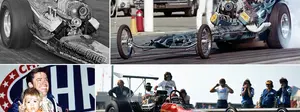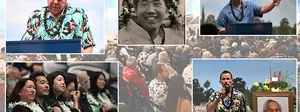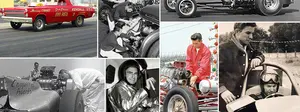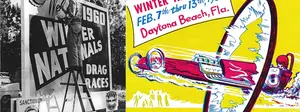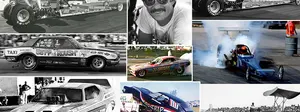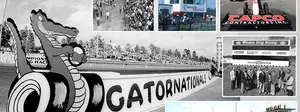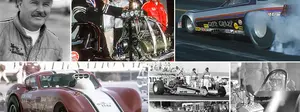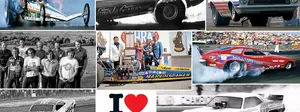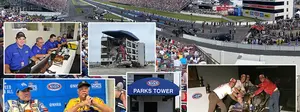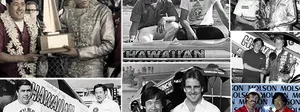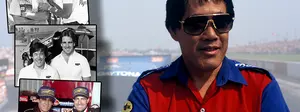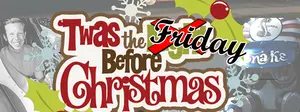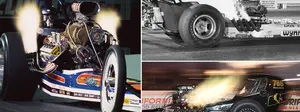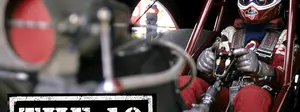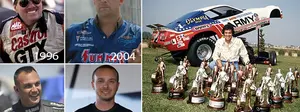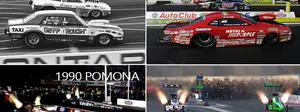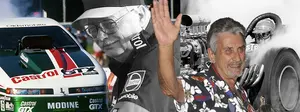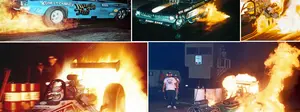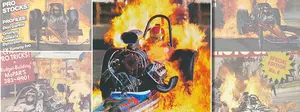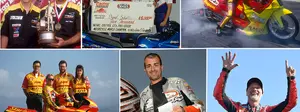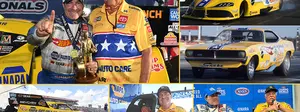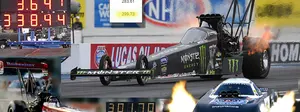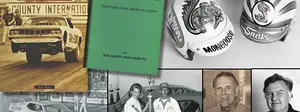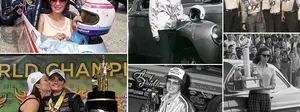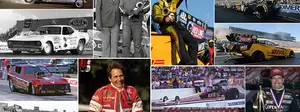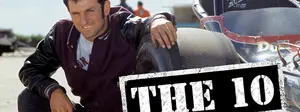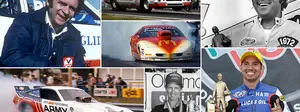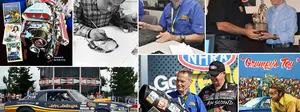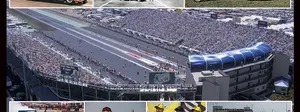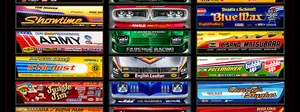Flaming hot magazine covers, cooked to order, sometimes overcooked
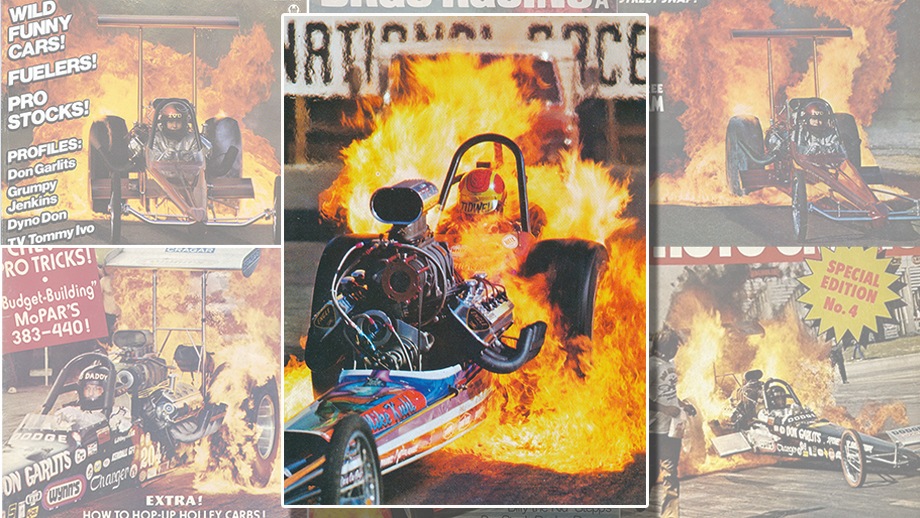
As long as there have been drag racing magazines, there have been photographers itching to illustrate their pages with the photos of far-away dragstrips you may never visit and cars that you may never see at your local track doing things that you never could have imagined seeing, all of this bringing us all that much closer to the sport we all love.
And as long as there have been photographers submitting photos to publications, they’re all in pursuit of the Holy Grail known as the elusive “cover shot,” the spectacular, unusual, or colorful image that is going to leap right out from the newsstand and demand you buy the issue.
Sometimes, a lot of planning goes into the setup for a proposed cover shot. This involves the willingness of the team to do whatever positioning gymnastics the photographer thinks will make “the shot,” the weather, the equipment, and the venue, just to name a few.
Sometimes it comes off flawlessly, and sometimes it doesn’t.
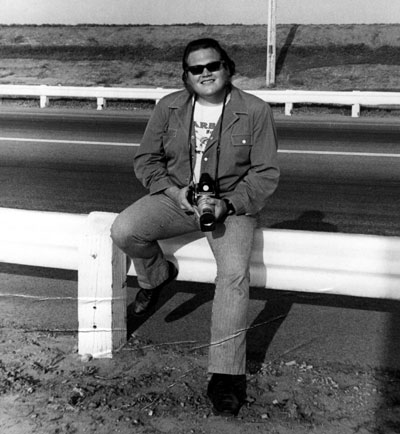
Hall of Fame photographer Steve Reyes — who has contributed so regularly to this column that I feel like he almost deserves a byline as I’ve routinely relied on his generosity (and apparently impeccable filing system) to quickly fill the image holes for stories I dream up when no photos are available in the vast NHRA archive — is here again to share a story of when it all went wrong, but somehow ended up right, with a cover shot on the front of the January 1971 issue of Popular Hot Rodding magazine.
Reyes pictured a spectacular fire burnout photo using the Mile Kuhl-owned, Billy Tidwell-driven slingshot Top Fueler and “kinda” got permission from Orange County International Raceway manager Mike Jones to shoot at OCIR.
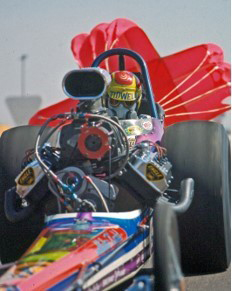 “All this started after Indy 1970,” Reyes remembers. “Tidwell had run into the ABC Wide World of Sports remote camera at the end of the track. The camera fell and did a number on the car’s nose and body. When Kuhl got home to L.A., I spoke with him about a fire burnout. Kuhl, being the lover of all things fire, thought it was a great idea. Tidwell was a bit put off about being set on fire, but, hey, it’s a chance to be on the cover of a magazine, so why not?”
“All this started after Indy 1970,” Reyes remembers. “Tidwell had run into the ABC Wide World of Sports remote camera at the end of the track. The camera fell and did a number on the car’s nose and body. When Kuhl got home to L.A., I spoke with him about a fire burnout. Kuhl, being the lover of all things fire, thought it was a great idea. Tidwell was a bit put off about being set on fire, but, hey, it’s a chance to be on the cover of a magazine, so why not?”
Before the big moment, Reyes had the foresight (or perhaps, premonition) to work up a substitute photo in case the fire burnout idea flamed out, so to speak, so they towed the car up and down the track a few times with the parachute deployed for some close-up photographer. Once that was in the bank, it was pyro time.
“Kuhl is gleeful, and Tidwell is wary of my master plan,” recalls Reyes. “I have told 'Fats,' Kuhl’s crew guy [real name: Don Mackay], when to pour the gas and when to light it. Kuhl will be off to my right and signal Tidwell when to nail the throttle.
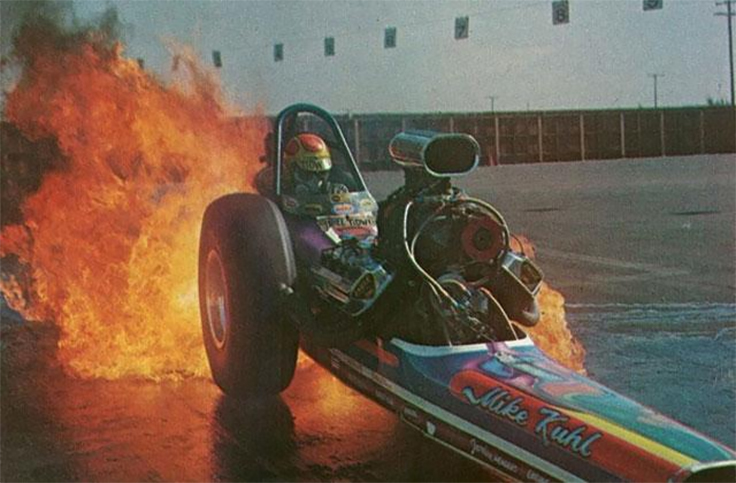
“Everything goes as planned, but the burnout (above) sucked. Our first try was wimpy, so Kuhl handed ‘Fats’ a bucket of gas for the second try. The car is fired and is sitting in the bleach box warming up. I’m checking my camera settings, and Kuhl gives ‘Fats’ the ‘pour' sign. ‘Fats’ takes the pail of gas and just blasts the car with high test, the gas hits the headers and ignites in a giant ball of flame. ‘Fats’ is standing there with all the hair burned off his right arm.

“The car is now sitting in a ball of fire, Tidwell looks down, and the cockpit is filled with fire so, signal or no signal, it’s time to go. Tidwell nails the throttle and parts the cloud of flames. He comes by me with the ‘chute pack on fire and the paint and decals burning off the car.
“Bill stops the steaming, smoking fueler and hops out with a very smoky firesuit. Kuhl seems amused by the whole deal; he was very humored by the melting bleach box. Mike Jones was not amused.
“I got my photo and hurried to Hot Rod Magazine with the slide in hand because I knew it was a cover. A.B. Shuman was the editor — a former airline pilot playing editor of a car magazine. I showed it to him, and it was deemed ‘too strong’ for the cover of Hot Rod. What does that mean?”
(Apparently, it means that it wasn’t a Funny Car? Looking through the book Hot Rod Magazine: All the Covers, Funny Cars of some kind were on seven of the 12 covers. Just sayin’.)
Anyway, Reyes ended up taking his hot shot to Lee Kelley at PHR, who loved it, put it on the January 1971 cover, which became one of their best-selling issues of the year, and even was turned into a poster and sold it through the magazine. And, to make further lemonade out of lemons, Reyes also sold one of the “practice ‘chute” photos to Drag Racing USA magazine, where it also was on the cover.
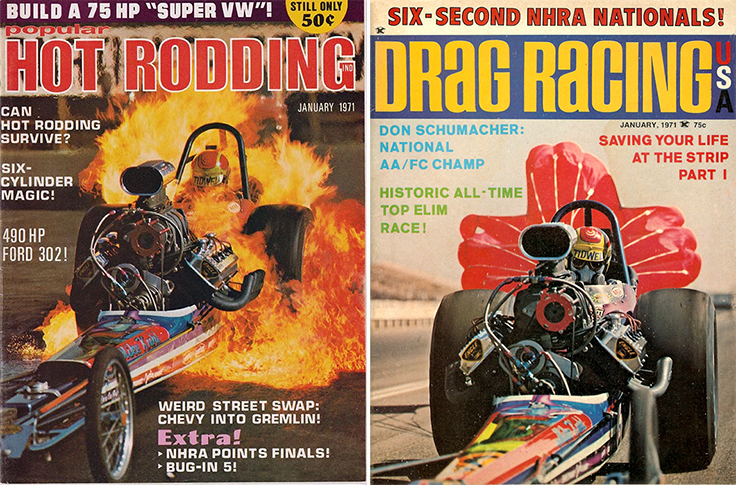
In case you’re interested in how to do correct fire burnouts, here’s a column I wrote, Fire in the hole, in which noted pyromaniacs Don Garlits and Tommy Ivo talk about their almost-regular fire burnouts, and, below, you can find a few more fire burnouts that weren’t “too strong” for other magazine covers, including two each from Messrs, Garlits and Ivo.

And finally, here’s a quartet of other great stories I worked on with Mr. Reyes that showcase some of his great work in setting up magazine shoots and being in the right place at the right time when things go wrong. Enjoy.
Five Fabulous Favorite Fotos: Steve Reyes
April 4, 2008: The dean of drag racing action photographers shares a handful of his famous and unforgettable photos
Reyes brings on the ugly
Nov. 8, 2011: Great photos of some not-so-great-looking cars showing battle scars, from our ol' pal Steve Reyes (and others)
Location, Location, Location
May 17, 2013: Steve Reyes shares the images and stories behind some iconic '70s drag mag location shoots
Location, Location, Location, Part 2
May 24, 2013: More great "on location" photos from Steve Reyes
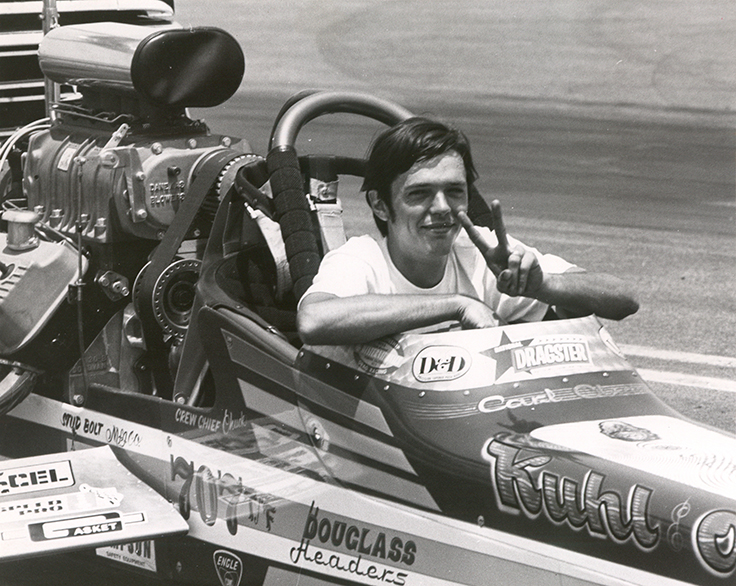
Well, that was where this column was supposed to end, but in chasing down some details — like 'Fats' real name, which Reyes did not have — I reached out to Tidwell's successor to the ride in Kuhl's dragster and my former NHRA colleague, the ever-eloquent Carl Olson (who just completed writing an encyclopedic autobiography of his life, available soon everywhere), who told me that the fire burnout fun didn't exactly end up there.
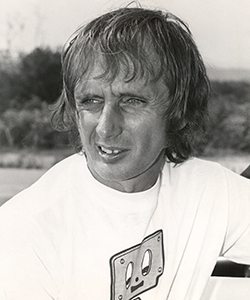
“Kuhl loved fire burnouts, but he just didn't understand what the appropriate limit of fuel should be,” related Olson, literally warming me up to the story. “In Kuhl’s world, if some was good, more was better, and too much was just right.
“Anyway, it was in late 1971, and Gary Densford, who was a photojournalist who was pretty active in drag racing back then, was in the process of producing a series of posters for sale, and the one thing he didn't have was he didn't have a fire burnout poster. And so he asked his buddy, Steve Reyes, who Steve thought might be up for doing a fire burnout. And it just so happened that Steve had a pretty firm recollection of the one Tidwell did at Orange County, and said, ‘Yeah, you need to talk to this Mike Kuhl guy. He's up for that kind of thing.’
“So, we called [Lions Dragstrip track manager] Steve Evans and asked, ‘What about if we come over to Lions on a weekday, when nobody's around, and do a fire burnout?’ and Evans said, ‘Yeah, OK, but not on my dragstrip. That's out of the question. But if you can do it on the return road, and you promise you won't damage it too much, you can do it over there.’
“So, we hauled the car up there one day and took some of the side panels off next to the engine. Reyes is up on the crossover bridge shooting down on the car, and Densford is at ground level. Kuhl got a quantity of gasoline that was way too much, and his theory was he'd just pour a horseshoe-shaped puddle of gasoline behind the car, and then he and ‘Fats’ would roll the car back into the gasoline and the headers should light the flame off, and Kuhl would give me a signal, and I would make a burnout.
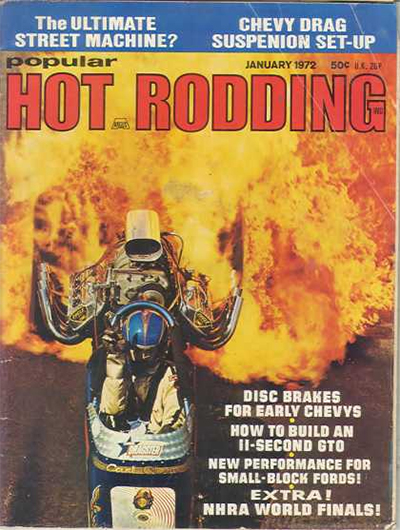
“Well, you know, the best-laid plans of mice and men and drag racers often go astray. When they rolled the car back, the headers did not ignite it. And now, of course, the gasoline is spreading out beyond the horseshoe, and pretty much covering the entire return road. While Kuhl is searching around for somebody with a book of matches or a cigarette lighter, I'm patiently waiting in the car for Kuhl to give me the high sign. And I'm waiting and waiting and waiting, and Kuhl has disappeared now because he's back behind the car trying to light the gas on fire.
“All of a sudden, I see him running for his life. He's not given me any kind of a signal or whatever; he’s just heading for the hills. I think, ‘It’s probably time to go,’ so I swapped feed and made a burnout. I pulled the fuel shut off and stopped and looked back, and it looked like the entire return road was ablaze and, of course, nobody had thought to maybe bring a fire extinguisher or some water or anything, and Steve Evans is just watching his return road in the process of melting. It finally burned itself out, and the photographs were absolutely amazing. Densford said that he sold more of that poster than all of the other posters he ever sold combined, and it also made it on the cover of Popular Hot Rodding [January 1972].”
OK, that's the real end of the column. Thanks for following along, and thanks, as always to Mr. Reyes (and Mr. Olson) and to all of the other wonderfully generous photographers who have allowed me to reproduce their photos here over the years. I used to joke that my job was to fill the space between photos with words, and I sometimes still feel that way.
Phil Burgess can be reached at pburgess@nhra.com
Hundreds of more articles like this can be found in the DRAGSTER INSIDER COLUMN ARCHIVE
Or try the Random Dragster Insider story generator


